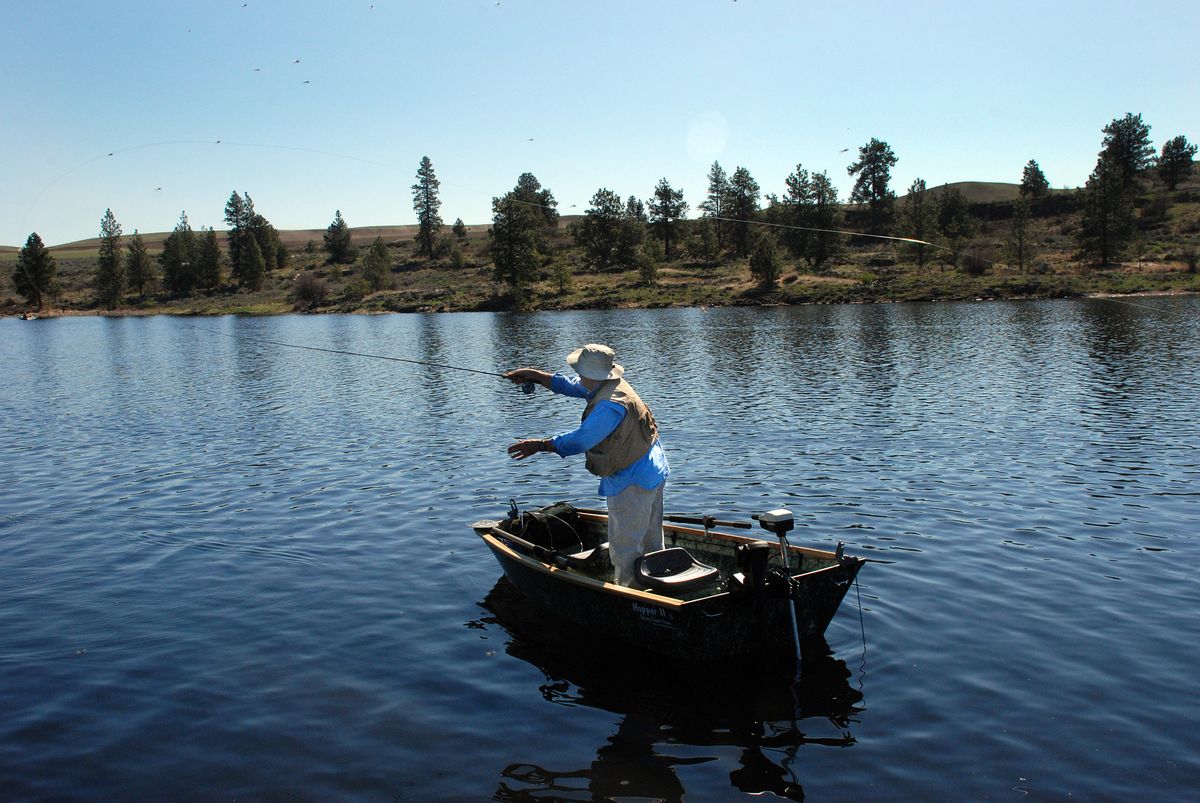Venerable vessel
The pram has given fishermen a stable foundation for 300 years

After years of floating loans as a banker, Jim Wheeler launched a business 15 years ago to float anglers.
Simple, light and elegant, his Spring Creek Prams have gained a following across the country, particularly among fly fishers looking for a stable casting platform on still waters or slow-moving streams.
The nearly flat-bottom boats allow anglers to sit or stand, allowing them to spot rises sooner, see deeper into the water and deliver flies with greater accuracy.
“My wife and I went through a tumultuous time for more than six years finding boat builders with the skills or time to keep up with our growing business,” Wheeler said.
“We finally decided to do it all ourselves,” he said, citing the decision eight years ago to move from Western Washington with their young daughter, Mackenzie, to a base overlooking Ell Lake about 18 miles east of Tonasket.
However, through the past three years, he learned the real meaning of tumultuous as well as disaster and heartbreak.
His wife, Shauneen, 52, died from an aggressive form of lymphoma last year, quickly erasing half of Wheeler’s boat-building partnership and a third of his family.
Wheeler said he has recommitted himself to his wife’s memory, his 15-year-old daughter and his product, which he continues to custom build himself with only minimal help.
“It’s all done in-house,” he said, noting that blemishes and defects simply don’t get out of the shop. “We haven’t seen a second in eight years.”
The wood or lightweight fiberglass versions of the flat-bottom boats are designed for convenience and stealth, whether they’re propelled by oars, electric motor or small outboard.
“I’ve fished from boats since I was 6 years old, and the bottom line is that a hard chine pram is the most stable,” he said. “It has a little more shape to give it more performance than a john boat. The pram has been a workhorse for 300 years.”
Spring Creek’s line includes prams with various options ranging from 8-foot solo boats to 10-foot doubles with a 14-footer design almost production-ready.
One man can easily load the Stillwater Classic into the back of a pickup, while some anglers prefer to haul them on roof racks or small trailers. Weights start as light as 60 pounds.
They’re not intended for big rough water, although Wheeler says he’s had no trouble negotiating 11/2-foot whitecaps in the 8-foot Stillwater Classic.
“My barometer: If it’s too windy for a fly fisher to cast well, it’s probably time to get off the water,” he said.
Frank Slak of Spokane, a veteran fly fisherman, is smitten with his 10-foot, two-seat Hopper II. The base boat weighs about 130 pounds and cost about $1,800.
“I have grandkids that just might want to go fishing,” said Slak, pointing out the two swivel seats and the beauty of the pram’s design. “There’s storage under one seat and the other seat has a battery compartment for the electric motor.”
The optional electric motor kit allows wiring to run through the hull so it’s not in the angler’s way.
“Two anchors are critical when you’re fishing chironomid patterns,” Slak said.
“All of these boats are designed so an angler can operate the front and back anchors without getting up from his seat.”
“You can tell a fly fisherman thought this out,” said Slak, pointing out the fly-line friendly components and the sound-muffling carpet.
The flotation tanks in the bow and both corners of the stern – this boat won’t sink! – are designed to shed fly line into the bottom of the pram.
“Even the extra rod holders on the side of the boat are installed with the tabs up so they don’t snag the fly line as you cast.”
Ash gunnels are beautiful while providing rigidity to the boat’s lightweight design.
“The bottom line is that wood is stronger that other materials,” Wheeler said. “The original 10-foot Hopper had rolled fiberglass gunnels and they didn’t hold up. With wood, their life is basically unlimited.
“I plan for these boats to be willed down to the owners’ kids.”
While the prams cost more than many styles of small boats, Wheeler says they offer another level of convenience above pontoons that are not all that cheap nowadays.
“In the time it takes to get into your waders, fins, float tube and to the water, you will already be fishing in a pram,” he said. “And you’ll be above water and warm.”
Wheeler said he invests 35-40 hours into each boat, although he builds several at a time for efficiency in the various stages, such as lay-up, gel-coating.
“I’ll spend three days just cutting the patterns for a group of boats,” he said.
He doesn’t rush orders. “I deliver in one or two months,” he said.
“That may sound long to some people, but I know the meaning of a lifetime now.”